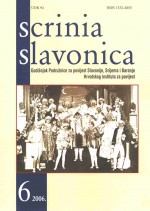Gorjani – srednjovjekovno sijelo plemićke obitelji Gorjanski
Gorjani – the medieval seat of the noble family Gorjanski
Author(s): Krešimir ReganSubject(s): History
Published by: Hrvatski institut za povijest
Keywords: Gorjani (Gora; Gara); Slavonia; Middle Ages; feudal castle; fortified palace; urban settlement
Summary/Abstract: This paper sets out to illustrate the historical development of the medieval Gora, which existed in what is known today as the village of Gorjani. We analyzed all material remnants of that medieval town, as well as all the historical resources pertaining to medieval Gora. Our research showed: first, that in the village of Gorjani, near Đakovo, there are remnants of the medieval urban settlement Gora; second, that the entire medieval settlement was located between the present-day Gorjani cemetery in the northwest and the village itself in the northeast; third, that the medieval complex was comprised of several units whereby each had emerged in the course of different periods of history: the feudal castle in what is now the village cemetery, a fortified settlement and a fortified palace in its southeastern corner, and the Ottoman tower in today’s Gorjani; fourth, that the beginning of the state of continued population of Gorjani can probably be traced back to as early as the VIth century, which is the time of Slavic settlement in the area. By the middle of the Xth century the Slavic people founded an early medieval župa (district) whose seat was located in the prefeudal župa’s fortress; fifth, that no later than towards the end of the XIth century did the early medieval kindred župa become a district forming a part of the royal county of Vukovo, while the kindred župa’s fortress became a royal fortress; sixth, that the Gora district existed all through the second half of the XIIIth century, when it was given (in 1269), together with the settlement and the fortress (the latter first being mentioned in 1256) to John and Stephen I de genere Drusma by duke Béla; seventh, that Gora remained in the ownership of their offspring, whose family name Gorjanski (de Gara) derives from the Gora fortress and the settlement, until 1481, when the last male member of the family died. During their reign the old kindred and royal fortress, i.e. the medieval building site, were destroyed, and in their place a contemporary fortress was build, i.e. a feudal castle, whose fortifications carried the features typical for military edifices of the XIIIth and the XIVth century; eighth, that the Gora castle was built according to design, i.e. on the basis of a project, and that it was swiftly erected in the course of 1380s where the old settlement used to be located; ninth, that due to the political and economic power of its landlords, primarily of the Gorjanskis and the Iločkis (= of Ilok), the Gora medieval town suddenly emerged as one of the most significant urban settlements of the middle part of the Sava-Drava river basins; tenth, that after the Gorjanski family, the medieval Gora was changing hands for years, whereby Lawrence Iločki deserves special mention since during his rule the castle was thoroughly reconstructed, expanded and enhanced with monumental secular buildings (a fortified palace) and religious edifices (Gothic church in th
Journal: Scrinia Slavonica
- Issue Year: 2006
- Issue No: 6
- Page Range: 127-159
- Page Count: 33
- Language: Croatian

